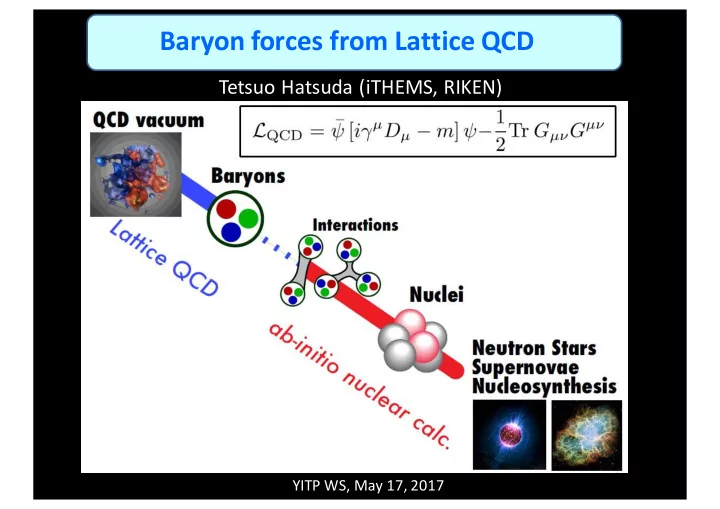

Baryon forces from Lattice QCD Tetsuo Hatsuda (iTHEMS, RIKEN) YITP WS, May 17, 2017
Contents 1. Introduction on hadronic interactions from LQCD 2. How “fake plateaux” ruin all the previous works (except for HAL QCD) ”Mirage in temporal correlation functions for baryon-baryon interactions in lattice QCD”, arXiv: 1607.06371 [hep-lat] (JHEP 10 (2016) 101) by HAL QCD Coll. “Are two nucleons bound in lattice QCD for heavy quark masses ? – Sanity check with Lucsher’s finite volume formula –” arXiv: 1703.07210 [hep-lat] (submitted to PRD) by HAL QCD Coll. 3. Hyperons in dense matter S. Aoki, D. Kawai, T. Miyamato, K. Sasaki, T. Aoyama (YITP) T. Doi, T. M. Doi, S. Gongyo, T.Hatsuda, T. Iritano (RIKEN) T. Inoue (Nihon Univ.) Y. Ikeda, N. Ishii, K. Murano (RCNP) H. Nemura (Univ. of Tsukuba) F. Etminan (Univ. of Birjand)
LQCD for multi-hadron (2015-) HAL QCD Collaboration K computer RIKEN (10 PFlops) 0.085 fm x 96 = 8.2 fm M π = 145 MeV 0.121 fm x 32 = 3.9 fm M π > 350 MeV
Fundamental difference between A=1 and A > 1 Single nucleon Two nucleons inelastic NN+π N+π Δ elastic NN N B Δ ~ Λ QCD 0 << Λ QCD
Fundamental difference between A=1 and A > 1 NN+π N+π δE Δ NN N B t -1 = Δ ~ 200 MeV t -1 = δE ~ 20 (9/L) 2 MeV
Scattering observables from LQCD J † x y J † space Imaginary time Finite Volume Method HAL QCD Method φ(r,t) à 2PI kernel (T=U+GUT) E n (L) à phase shift, binding energy à phase shift, binding energy Ishii, Aoki & Hatsuda, PRL 99 (2007) 022001 Luescher, Nucl. Phys. B354 (1991) 531 Ishii et al. [HAL QCD Coll.], PLB 712 (2012) 437
Problem of Signal to Noise Ratio Parisi, Lepage (1989) Single pion Signal/Noise ~ √N conf Multi pion Signal/Noise ~ √N conf Single nucleon Signal/Noise ~ exp(- m N t) x √N conf Multi nucleon Signal/Noise ~ √exp(- A m N t) x N conf
Fundamental difference between A=1 and A > 1 NN+π N+π δE Δ NN N B t -1 = Δ ~ 200 MeV t -1 = δE ~ 20 (9/L) 2 MeV S/N ~ exp(- 2m N t) x √N conf S/N ~ exp(- m N t) x √N conf ~ 10 -41 x √N conf ~ 10 -2 x √N conf
Demo by Mock-up data @ m π =0.51GeV, L=4.3fm Same setup as Yamazaki et al. (’12) Ground state energy : ~ 1 MeV precision required Elastic scattering threshold : sensitive to L (10% contamination) Inelastic threshold : insensitive to L (1% contamination)
True ground state for t > 10 fm “Fake plateaux” or “Mirage” at t ~ 1 fm Zoom + typical stat error
Actual data for ΞΞ ( 1 S 0 ) @ m π =0.51GeV, L=4.3fm, a=0.09fm Source dependence
Actual data for ΞΞ ( 1 S 0 ) @ m π =0.51GeV, L=4.3fm, a=0.09fm Sink dependence smeared source wall source All the previous results (Yamazaki et al., NPL QCD, CalLat) T. Iritani et al. (HAL) using the smeared source were looking at ”Fake Plateaux”. JHEP1610(2016)101
Analysis of all existing data for Baryon-Baryon interactions using plateau method
Summary Table : At least single “No” implies the result is “Mirage” 11/01/2013 15
Luscher’s formula: Scatterings on the lattice Schroedinger eq. in (1+1)-dimension: Wave function at |x|> R |x|<R for infinite L: Quantization condition for finite L with PBC: Lucsher’s formula in (1+1)-D
Luscher’s formula: Scatterings on the lattice NBS equation in (3+1)-dimension: L R Wave function at |x|> R for infinite L: Wave function at |x|> R for finite L with PBC: Quantization condition for finite L with PBC: Lucsher’s formula in (3+1)-D
Effective Range Expansion (ERE) infinite V S-matrix Im[k] X Re[k]
Effective Range Expansion (ERE) finite V S-matrix Im[k] x x x x Re[k] Dotted lines from Luscher’s formula
“Sanity Check” for all the existing data T. Iritani et al. (HAL) arXiv:1703.07210 Data by Yamazaki et al (2012) Data by NPL Coll. (2015) (ii) Singular behavior (i) Inconsistent ERE (iii) Unphysical pole residue
Summary Table : At least single “No” implies the result is “Mirage” 11/01/2013 21
HAL QCD Method : the Master equation J † x y J † space Imaginary time R(r,t) à 2PI kernel (T=U+GUT) à phase shift, binding energy Ishii, Aoki & Hatsuda, PRL 99 (2007) 022001 Ishii et al. [HAL QCD Coll.], PLB 712 (2012) 437
Time-dependent HAL method N.Ishii et al. (HAL QCD Coll.) PLB712(2012)437 All the elastic states share the same non-local potential U(r,r’) Inelastic NN π Elastic NN . . . All equations can be combined as Plateau method HAL QCD method Inelastic states Noise Noise Elastic states Noise Signal Ground state Signal Signal Exponential necessary t t > 10 fm t ~ 1 fm Improvement !
HAL QCD Method a=0.09 fm m π =0.51 GeV m K =0.62 GeV Fate of the fake plateau No ΞΞ bound state
Physical point LQCD studies on multi-hadron (2015-) HAL QCD Collaboration 0.085 fm x 96 = 8.2 fm M π = 145 MeV
T. Inoue (HAL QCD)
(BHF) T. Inoue (HAL QCD)
T. Inoue (HAL QCD)
Summary 1. Introduction on hadronic interactions from LQCD Physical point BB data are now available 2. “Fake plateaux” ruin all the previous works except for HAL ”Mirage in temporal correlation functions for baryon-baryon interactions in lattice QCD”, arXiv: 1607.06371 [hep-lat] (JHEP 10 (2016) 101) by HAL QCD Coll. “Are two nucleons bound in lattice QCD for heavy quark masses ? – Sanity check with Lucsher’s finite volume formula –” arXiv: 1703.07210 [hep-lat] (submitted to PRD) by HAL QCD Coll. 3. Hyperons in dense matter
Recommend
More recommend